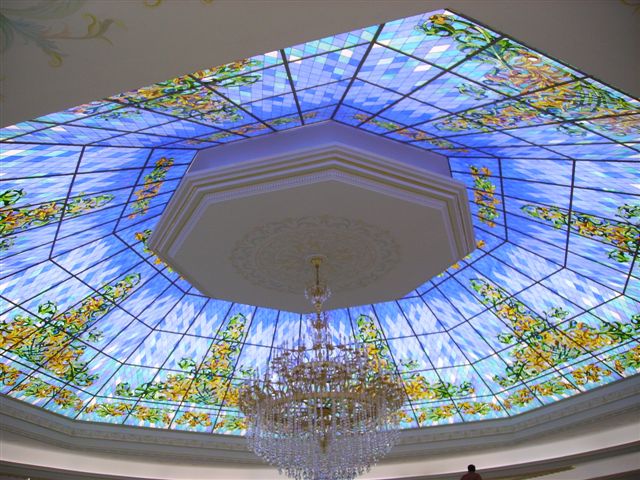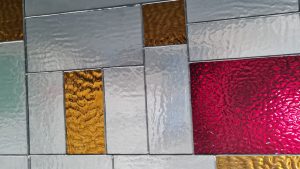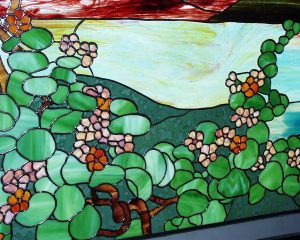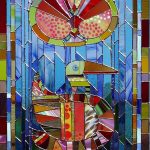
19 Jun TIFFANY, NOT A SIMPLE GLASS-BINDING TECHNIQUE.
From the hands and mind of Louis Comfort Tiffany, in the United States at the end of the nineteenth century, an innovative technique, that gave life to soft designs and plastic works of exceptional artistic value, was born.
The technique created, in it, is very simple but, like the egg of Columbus, it cannot be realized without extreme attention and care for detail.
Each piece of the glass mosaic that you want to compose must first be surrounded by a very thin strip of copper foil that covers, in part, the thickness on the two surfaces, like a kind of “C” or “U”, and then, by putting together all the tiles so outlined, bound by molten tin. Finally, the glass is turned and tinned on the other side. The apparent simplicity hides the need for everything to be very well finished.
 The ingenious aspect and innovation brought by Tiffany was that, for this technique of glass binding, you can cut the pieces in any way and even undercuts.
The ingenious aspect and innovation brought by Tiffany was that, for this technique of glass binding, you can cut the pieces in any way and even undercuts.
The latter aspect can easily be compared with the oldest lead binding technique. Here, on the other hand, we use a lead rod that has an “H” section and, on this section, we place a glass that enters on one side and one that enters on the other. However, if you want to make a drawing where there are undercuts it is not possible to make a glass enter through a smaller hole that then widens.
So, you need to create the design considering the difficulty of inserting glasses. With the lead binding technique, you start at one angle and put a glass followed by lead, then another glass, lead, and so on. If there are difficulties in getting the glass in, you need to make changes: cut the glass differently or change the design.
With the Tiffany technique this problem is solved because the glasses can be placed one after another on the plane, creating this set of joined tiles, where the tin will then be poured to weld them all together.
Louis Comfort Tiffany had an innate talent and enormous creative abilities as he created works that were, in all respects, incredible objects of art: the most famous are table lamps.
His genius also led him to produce glass and created it multi-coloured so that, in his works, with a sheet of glass inside which were included thousand multi-coloured shades, he could choose and cut the glass at the exact point of the shade of his interest.
In addition to this, he worked with tin and binding creating real sculptures of this material. There is a beautiful paravent with an art nouveau rose garden, with round and soft shapes, where the background and flowers are obviously in glass and bound together but, the stems with the spines of the roses are made as a metal bas-relief. His creations were not just the union of two glasses but real artworks.
An interesting project, commissioned by the company Aggio Light, of Piombino Dese (Padua), which then also took care of on-site assembly, was that of the glass windows for jewellery shops bearing the same name as the technique and its inventor: Tiffany.
 The contract involved the production of large-scale glazing, and here the limits of this technique came into play, given precisely the final dimensions of the glazing.
The contract involved the production of large-scale glazing, and here the limits of this technique came into play, given precisely the final dimensions of the glazing.
A standard glazed window, depending also on the design that I remember commands in this technique, has dimensions that are around the square meter of surface.
The windows that were commissioned to me were about one meter sixty of base by three meters fifty in height and, to make the realization even more difficult, a rectangular hole was planned at eye level, which should have contained a window.
The subject was not difficult but, the challenge was in the realization of the glass itself.
The design consisted of an enlarged Tiffany-stained glass window with branches of leaves falling from above, on a background in the blue and blue tones typical of the brand.
To be sure that the installation of the windows respected certain safety standards, we thought of placing each of them inside two glasses that proposed the hole required for the window.
We knew right away that it was impossible to build the glazing in one piece because you couldn’t even turn around for welding from both sides. We have therefore divided it into horizontal bands, following the design and proceeding from the bottom up in the realization. Finally, to fit it inside the glass-chamber, we had to complete the welding work inside the glass itself.
The operation had to be thought out and planned. It was not natural to think of making a stained-glass window of this size in the way it had always been done. Also, for this, you can call the Tiffany technique very simple, but the creation must be artistically and technically valid.

Plato believed that ideas did not belong to rationality and intellect but that they came from another world in the form of intuition. So, even the ability to do difficult things happens simply because ideas come from somewhere. Know-how and experience are at the service of these ideas and help them to become reality. It is not enough to decide whether to accept a challenge, you have to think about how to implement it.
Vittorio Benvenuto